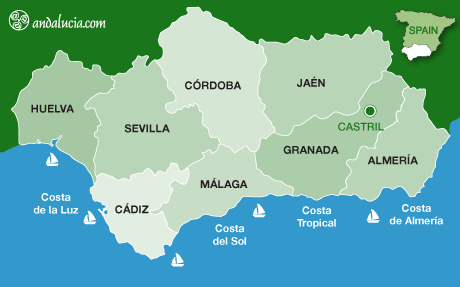Castril is one of the six villages which make up the Huescar region in the Province of Granada and is about 150 kilometres from Granada City. The village is set at an altitude of 890 metres and has a population of 2,656. This idyllic countryside hamlet is situated on the edge of the Province of Jaen, bordering on the stunning natural park of Cazorla. Since 2001, Castril has been officially recognised as a place of historic interest. The steep, narrow cobbled streets, with the typical whitewashed houses are all part of the authentic Andalusian village life. Of particular interest in the general structure and decoration of the houses, is the use of Arabic tiles and wood. There are a few cafes, bars and restaurants, where you can sample the local wine and cooking at very reasonable prices.
Book your stay in Andalucia Now!
The surrounding countryside is perfect for walking and cycling in the good company off fragrant almond trees and olive groves, to say nothing of the crazing goat herds and passing donkeys. There is a village market every Friday, when the place comes alive with visitors from all around. Unlike the busier coastal areas, very few people here speak English, making the experience more truly Andalusian. However, visitors are made welcome and there is a tourist centre with interesting information on the village, including a museum, a short video on Castril. There is also interesting information available on birds (such as vultures and eagles) and wildlife in the area. In summer the centre opens every day, but in winter it is only open from 12:00 - 14:00, from Thursday to Sunday.
Castril has very hot summers and cold nights in winter, especially when snow fall caps the mountains. The Sierra de Castril is very popular in summer for outdoor sports such as canoeing, etc on the Bolera and San Clemente reservoirs. There is also caving, rock climbing, horse riding and mountain biking all within close proximity to the village.
History
It is thought that the name Castril comes form the word 'castro' encampment - from the Roman times when they set up military camp there. Then when the Muslims took over, Castril it turned into a fortification. With the conquest of the Catholic Kings at the end of the 15th Century, it became a model example of a place where the three cultures; Muslim, Christian and Jewish peoples lived side by side. Later when the Moors were ousted, Hernando de Zafra took over the running of the village and was known as the Señor de Castril. In the 19th century there were important battle scenes there during the Napoleonic invasion. Many of the trees of its great forests were lost during the reign of Felipe II and up to the first half of the 20th century.
Mirador (Viewpoint) Peña del Sagrado Corazón
There is a wonderful viewpoint, the Peña del Sagrado Corazón, right in the heart of the village. The views from this and another point known as El Cantón are absolutely stunning of the breathtaking surrounding natural countryside.
The Glass Factory Building
The old glass factory is a memory of times gone by, dating back to the times of the Catholic Kings. This was sadly shut down at the beginning of the 20th century, but some of the products made there are kept on display at the Reception Centre of the Natural Park of the Sierra de Castril
The Church of Santa Maria
The Church of Santa Maria is one of the most interesting buildings in Castril. It was built around the middle of the 16th century as is clear by the presence of the Coat of Arms of the Cardenal Tavera of Toledo. The historic connections with Toledo and Salamanca are evident the structure of the building facade. Some damage was suffered by the church during the War of Independence. However there are still remains of ramparts and towers from Arabic times, as well as part of a roman bridge which was built some two thousand years ago.
Fiestas
Although the feria (fair) of Castril is held during the hot month of August, it is the October festival that is best known and enjoyed by villagers and visitors alike. There is a week of celebrations, including the running of the bulls. Another festival worth seeing is the Romeria on the last Sunday of April, held in honour of the Virgen de la Cabeza.
Gastronomy in Castril
The people of this white Andalusian village enjoy simple, wholesome home cooking, which you can sample in one of the little bars or restaurants. You will find fresh fish dishes available, as well as many recipes with lamb and goat. There is also a good tradition of cooked meats and also delicious wild mushrooms. Olive oil, garlic and almonds are often included in the many natural ingredients in stews, salads and sweets.
For further information, contact the Town Hall (Ayuntamiento) of Castril:
Ayuntamiento de Castril
Plaza Hernando de Zafra, 1
Tel: 958 720 001
Fax: 958 720 073
